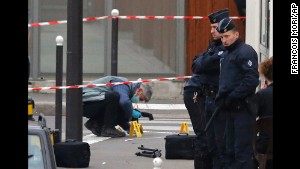- Two gunmen at a Mohammed cartoon event in Garland, Texas, were killed by police
- Violence aimed at those who draw cartoons of the Prophet Mohammed occurred in Europe
- Peter Bergen: It was only a matter of time before it happened in America
By Peter Bergen, CNN National Security Analyst
Peter Bergen is CNN's national security analyst, a vice president at New America and professor of practice at Arizona State University. He is the author of "Manhunt: The Ten-Year Search for bin Laden - from 9/11 to Abbottabad." This is an updated version of an article that appeared in February.
(CNN)It was only a matter of time before this would happen in the United States.
Violence in the West aimed at those who draw cartoons of the Prophet Mohammed has become increasingly common. In January, 12 people were killed by two gunmen at the Charlie Hebdo satirical magazine in Paris, which had run a number of cartoons of the Prophet Mohammed.
Peter Bergen
A month later in Copenhagen, Denmark, at an event featuring Swedish cartoonist Lars Vilks, who had also drawn cartoons of the Prophet Mohammed, one of the attendees was killed by a gunman who had pledged allegiance to ISIS. On Sunday, two men opened fire outside the "Muhammad Art Exhibit and Cartoon Contest" in Garland, Texas. Both gunmen were killed by police. Dutch politician Geert Wilders was the keynote speaker at the event in the Dallas suburb. Wilders released a 2008 film that showed terrorist acts superimposed over verses from the Quran. One of the gunmen was identified as Elton Simpson, a federal law enforcement told CNN. Simpson lived in Phoenix and had been the subject of an FBI investigation into whether he had planned to go and fight with Islamist militants in Somalia in 2009, according to court documents. Up until Sunday night Americans might have taken some comfort in the idea that this sort of attack wouldn't likely involve a U.S. citizen or happen in the States. Think again.

Gunmen opened fire at Mohammed cartoon event 02:07
PLAY VIDEO
Pennsylvania resident Colleen LaRose, a 46-year-old high school dropout who called herself "Jihad Jane" when she was surfing jihadi websites, pleaded guilty in 2011 to being part of a plot to kill Lars Vilks, the same Swedish cartoonist whose support group was targeted in Copenhagen. LaRose traveled to Europe and also followed Vilks online "in an effort to complete her task," according to federal prosecutors. In 2007, Vilks had drawn a cartoon of Mohammed with the body of a dog. According to the indictment against her, LaRose emailed the Swedish Embassy in Washington asking for instructions about how to become a permanent resident of Sweden. LaRose also sent emails to another American citizen, former Colorado resident Jamie Paulin Ramirez, during the summer of 2009 inviting her to Europe and asking her to attend a "training camp." Ramirez traveled to Ireland in September 2009 with "the intent to live and train with the jihadists," according to prosecutors. Ramirez pleaded guilty in 2011 to charges of conspiring to provide material support to a terrorist organization and was sentenced to eight years in prison. LaRose was sentenced last year to 10 years in prison. Over the past four years, three American citizens have been convicted in plots to murder Scandinavian cartoonists and journalists who they believed had insulted Islam. And two other Americans have also been convicted of inciting violent attacks against cartoonists in the States who they felt had insulted the Prophet Mohammed. Chicagoan David Headley -- who played a critical planning role in the attacks in Mumbai, India, in November 2008 by the Pakistani terrorist group Lashkar-e-Taiba that killed 166 people -- also hatched a plan to attack the leading Danish newspaper Jyllands-Posten, which had published cartoons in 2005 of the Prophet Mohammed that were considered offensive by many Muslims. In January 2009, Headley traveled to Copenhagen, where he reconnoitered Jyllands-Posten on the pretext that he ran an immigration business that was looking to place some advertising in the paper.

Controversial cartoonist on al Qaeda 'Most Wanted' list 03:03
PLAY VIDEO
In coded correspondence with his Lashkar controllers in Pakistan, Headley referred to his plot to take revenge for the offensive cartoons as the "Mickey Mouse project." Headley hatched a plan to take over the Jyllands-Posten building with multiple attackers using similar tactics to those that Lashkar's gunmen had used in Mumbai. The plan involved beheading employees working at the newspaper and throwing their heads out the windows of the building, in an act guaranteed to get worldwide media coverage. While he was in Denmark, Headley picked up some hats with the word "Copenhagen" emblazoned on them, a grimly ironic souvenir that he gave to some of his Lashkar handlers when he was back in Pakistan. But Lashkar officials suddenly put the Copenhagen attack on hold because of the pressure the group was feeling as a result of the Mumbai attacks, which had led to more carnage than even they had anticipated, causing them to worry that there might be a major crackdown on the group. Resolved to defend the honor of the prophet from what he believed were the blasphemous Danish cartoons, Headley was determined to go ahead with the Copenhagen operation, so he made contact with Ilyas Kashmiri, who ran his own jihadist group in Pakistan and also had close ties to al Qaeda.

Lawmaker: Paris gunmen were 'very well trained' 04:45
PLAY VIDEO

French magazine known for outrageous satire 02:34
PLAY VIDEO
Kashmiri told Headley that he had men in his group who were living in the United Kingdom who might be interested in taking part in such an operation. Headley traveled to meet them in the city of Derby in northern England and talked to two of the men who Kashmiri had said would be good recruits. These men were being monitored by British intelligence, which tipped off the FBI in July 2009 after someone named "David" had called them from a Chicago pay phone. Headley was arrested at Chicago's O'Hare Airport on October 3, 2009. He soon told investigators that he was planning to kill the Jyllands-Posten's cultural editor, Flemming Rose, who had first commissioned the Danish cartoons, as well as the cartoonist Kurt Westergaard, who had drawn the cartoon he found most offensive: the Prophet Mohammed with a bomb concealed in his turban. Headley later pleaded guilty to the conspiracy and was sentenced to 35 years in prison.

Paris attack: 12 dead, massive manhunt continues 02:43
PLAY VIDEO
Also, American Muslims have incited fellow Muslims to kill cartoonists in the United States who they believed had insulted the Prophet Mohammed. On the occasion of the 200th episode of the Comedy Central show "South Park," Trey Parker and Matt Stone, the creators of the show, decided to have some fun with the notion that Islamist militants had deemed that depictions of the Prophet Mohammed should be met with violence. The 200th episode aired on April 14, 2011, and to avoid showing the Prophet Mohammed's face, the animated character playing the prophet was dressed in a bear costume. A character in the show pointed out, "If Mohammed is seen we could get bombed."

Who was behind Paris terror attack? 02:10
PLAY VIDEO
The day after the "South Park" episode, Chesser wrote that the episode "outright insulted" the prophet by showing him in a bear suit. Chesser went on to say, menacingly, "We have to warn Matt and Trey that what they are doing is stupid, and they will probably wind up like Theo van Gogh for airing this show. This is not a threat, but a warning of the reality of what will likely happen to them." Van Gogh, a Dutch filmmaker, was killed by an Islamist militant in Amsterdam in 2004 after he made a provocative film that showed naked women with verses of the Quran projected onto them. Chesser posted a photograph showing van Gogh lying dead in the street in Amsterdam with two knives stuck into his body. Chesser also posted the address of Comedy Central in New York and linked to an article about a residence in the western United States belonging to Trey Parker and Matt Stone. He suggested to his readers that they should "pay them a visit." Given the fact that the readers of Chesser's blog were mostly a group of Islamist militants who might actually retaliate against someone they believed had defamed the prophet, this was a serious threat. To underline the threat, Chesser posted photos of Parker and Stone along with photographs of others who had been publicly targeted for death for purportedly insulting the prophet, including British author Rushdie and Danish cartoonist Westergaard.
